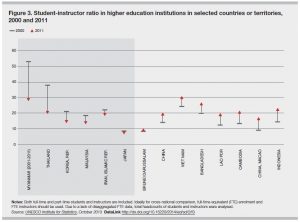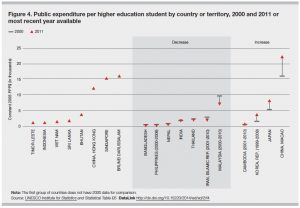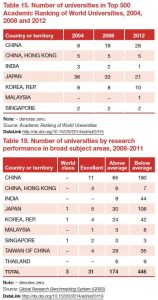
Monthly Archives: February 2017
Europeanizing Turkish Higher Education
Last week, our readings dealt with higher education regionalism, with a particular emphasis on Europe. We read, for instance, the introduction to European Integration and the Governance of Higher Education and Research. There, Peter Maassen and Christine Musselin introduced the various processes of European integration and mused on their effects on policy at the national and university levels. In particular, Maasen & Musselin were interested in the effects of the Bologna process, noteworthy because it’s product, the Bologna Declaration, was the first affirmation by EU member states that an integrated higher education environment was a goal of the wider effort to integrate Europe.
Maassen & Musselin emphasize that the path to the Bologna Declaration was an arduous one, though in 1999, when the Declaration was signed, many of the states which typically prove controversial in debates regarding EU expansion had yet to be admitted (I’m thinking here of Eastern Europe and the Balkans- most of which did not join until after 2004). Because the Bologna declaration has grown to include non-EU member states, I was curious to know more about how less ‘Western’ countries aiming to align with the EU accommodate the integration process in the higher education sector. As recently as 24 January 2017, the comparative education journal Compare published a piece by Ozge Onursal-Besgul titled “Translating norms from Europe to Turkey: Turkey in the Bologna Process.”
Onursal-Besgul examines the process undertook by Turkey to integrate itself within the European educational space through the Bologna Process, from 2001 to 2012. The author raises two questions: first, what is being transferred from the European higher education space into the Turkish space? Second, how is the transfer being conducted? Ultimately, Onursal-Besgul concludes that the process of integration for Turkey has been delayed by the relative paucity of actors working towards the goal and by certain effects stemming from that. Specifically, Onursal-Besgul observes that too much of the responsibility for managing Turkey’s integration has been placed in one office, the Council of Higher Education. As a result, there is little buy-in from elsewhere in Turkish government or society, and the reformation process has been largely conducted from the top-down. The Turkish experience is different, therefore, from the wider European experience, which relied on horizontal cooperation between universities and national governments, instead of Turkey’s more authoritative approach.
The piece raises a number of questions relevant to our readings and about the challenges that policymakers face in regionalizing higher education. One question I still have is whether it is wise for established regional education spaces, like the European Higher Education Area, to accept that states are using the regionalization process as a catalyst for long overdue domestic reforms? This question has plagued the EU in a number of policy areas as it has expanded south and east over the years.
Art, Racism, and Higher Education
Hello, all!
My name is Gayoung Kim and I am in the art group. While googling, Timothy and I found an interesting dance performance to share with everybody. It is called, Octavia’s Brood: Riding the Ox Home, performed by an anti-racist choreographer, Meghan Abadoo. She, as a black woman dance performer, tries to reveal the identity of black womanhood (It is all performed by black female dancers) and to create a space for freely sharing the vulnerability of black women with the witnesses who watch the performance. Throughout the performance, one movement captured my sight really strongly when the performers try to run forward but they keep failing because of cloth tying their bodies to the walls from 26’-33’. (The whole performance is 46 minutes, but I think this part is the highlight.) The dancers keep trying to reach forward but they tumble and fall, and I felt like that is the reality of racism and gender discrimination.
Meghan Abadoo also wrote a short essay about the subtle systematic injustice in society and how University of Maryland tries to deal with it. She points out that it is a widely held misconception that racial inequality does not exist anymore because race-based discrimination is illegal and shares the moment when she participated the Words of Engagement intergroup dialogue program at University of Maryland. There, she had profound experience gathering with people of different racial backgrounds, listening divergent viewpoints and stories.
Personally, as an Asian female student, I have not experienced specific occasion, but her words made me think about how race and gender are still the issue to resolve and how those are under-estimated as a problem. I think this performance is a worth while piece to watch.
You can watch the performance here:
http://drum.lib.umd.edu/handle/1903/18432
And her essay, you can read it here:
http://terp.umd.edu/sights-unseen-2/#Abadoo
And here some inviting questions to think for you all;
- Do you think racial or gender discrimination is still prevalent in US higher education institutions today?
- What do you think are the merits and limitations of Abadoo’s project of using dance as a medium to champion notions of racial and gender equality in HE institutions?
- Are you able to think of any other ways for HE institutions to leverage their academic and cultural influence to advocate social causes in the world? How might these ways or approaches differ in an Asian HE context?
Quality of Higher Education in South Asia
Last week we looked at some indicators of Higher Education access across South Asian countries that elicited some very interesting discussion. This week, we mined some more data from UNESCO’s Institute of Statistics on higher education quality across the South Asian countries. Coincidentally, it ties it neatly with this week’s News post on the newly released Times HE Rankings! Below are some infographics on the student-instructor ratios, public HE expenditure per student and academic rankings across South Asian countries.
Quality of higher education is tough to measure and these indicators are far from perfect. What other information would you like to have on HE quality in other countries? Do you think that it is fair to apply the same normative criteria of ‘good quality’ for developed nations and for developing economies? What are the the benefits for South Asian nations in chasing these quality targets?
Source: Higher Education in Asia: Expanding Out, Expanding Up (http://www.uis.unesco.org/
The ratings are in! “The World’s Most International Universities 2017”

Image Source – “The World’s Most International Universities 2017”
https://www.timeshighereducation.com/features/worlds-most-international-universities-2017
The ratings are in! Two South East Asian universities beat the US and UK in rankings for the world’s most international universities in 2017 indicating that utilizing English as a language of instruction and geographical location can provide Asian universities a competitive advantage. The question now is, will HEIs in other South East Asian countries utilize the “opportunity” produced by political turmoil in the US/UK to steer international students to South East Asia? If so, how?
You will find the full article at – https://www.timeshighereducation.com/features/worlds-most-international-universities-2017#
If you’re interested in India…
Hello!
I was Googling things and I came across an op-ed on the Brookings website: “Strengthening India-U.S. Relations through Higher Education.” If you’re interested in higher education in India, take a look if you want!
https://www.brookings.edu/opinions/strengthening-india-u-s-relations-through-higher-education-2/
International Comparison : Gross Enrollment Ratio
New era for Higher Education? Minerva University
Ben Nelson, “Taking on the Ivy League”
Source: https://www.youtube.com/watch?v=WEv8g80lcjo
Continuing on from our heated conversation in class on Thursday about Minerva University, the Arts group thought to dig a little deeper into the conversation of twenty-first century higher education in the world. Ben Nelson is the founder, chairman and CEO of the Minerva project, and formed the Minerva Schools at KGI, also known as the Minerva University. This TED Talk by briefly explained his purpose and reasons of creating Minerva University.
The four key areas of higher education he elaborated on: access, affordability, instruction and outcome, prompted us to rethink the purpose of receiving a higher education and what is considered an appropriate outcome of your higher education experience.
In terms of access, what do you think is the purpose of the highly selective admission processes of the Ivy League schools? Try to forget about the Ivy Leagues and big names, what would the world’s greatest education look like to you? Ironically, when Ben Nelson talked about how Ivy League schools had limited its number of admitted students and are highly selective, Minerva itself became one of the most selective and competitive schools to get into in the world.
At last, what do you think of technology’s role in reimagining and reshaping higher education today? Do you believe that Minerva will eventually be the future of higher education?
Here are additional videos on Minerva University: https://www.youtube.com/watch?v=n201cHf88O4
From Japan: “Universities’ Failing Grades”
Hello Everyone!
The News Group’s first article, “Universities’ Failing Grades,” comes from the Japan Times. It is linked below, or can be found by googling “japan times universities’ failing grades 10/2/2016”
Since the topic of university rankings came up in the class, we thought this article was appropriate for this week. The writer discusses Prime Minister Abe ‘s “target of Japan getting at least 10 universities in the world’s top 100 within 10 years,” the realities of actually meeting that target, and how Japan’s bureaucracy is a large cause of its failings.
Presentation – Gender Equality as a Norm in the Higher Education Reform Narrative in Asia: The Case of Pakistan
Presentation given in class on the 2nd of February 2017 – Click on the following Link to access the file Gender Equality as a Norm in the Higher Education Reform Narrative in Asia: the Case of Pakistan
Here you find an updated version of the presentation with additional readings if you are interested in learning more – Bajwa _Presentation_HigherEduinAsia_ February 2 2017 Additional Readings-21y9uun
Please message me if you have any difficulties accessing the presentations!




